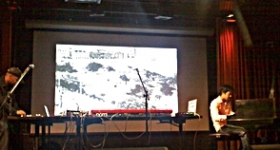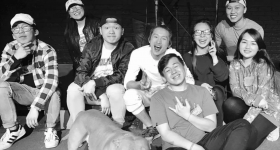APRIL 1971. It’s a cold night at the outdoor Greek Theatre and the seats are made of stone. But at the Berkeley Jazz Festival, the music is always worth the pain. Up on stage, a river of sound streams from Alice Coltrane’s harp, and Archie Shepp wails out on his tenor sax. With bassist Jimmy Garrison and drummer Clifford Jarvis driving the rhythm, the power of the music lifts up even those in the nosebleed seats. But the night belongs to Alice Coltrane and the spirit of her late husband and saxophone great John Coltrane, or “Trane.” This is still their journey to the extremes of musical sentiment, an exploration that took them to the music of Africa and Asia, especially that of the Asian subcontinent. As musicians looked beyond the canons of Western music, the music of South Asia was a key stopover, a way to meld spirit and sound.
Alice Coltrane said her involvement with Indian music began with Trane. “He had a great interest in Eastern philosophy, spirituality, music. We were attracted by the sound. It was the sound of devotion, the sound of energy, of peace.” Trane’s melding of spiritual and musical exploration spoke to his belief in a universal music structure, one that looked beyond ethnic delineations. Much of his later music was influenced by Indian ragas. By 1971, Alice Turiya Coltrane continued on the same religious and musical path on which she and Trane had started. It was intertwined with that of the Hindu faith, and that year, the music she played up at the Greek sat on a vibe, on cycles of sound. It crashed up on the shores of a sleeping America and woke everyone up.
It was a sign of the times.
1971. The turmoil has settled somewhat on the University of California, Berkeley campus. Asian American student activists are still highly politicized in the post-Civil Rights era and after the Third World strike at San Francisco State University. Ethnic studies is a fairly new hard-won victory. The war in Southeast Asia is ending but another is starting in Central America. Nixon and Reagan will pull punches that we’re still reeling from. But on those nights up at the Greek, the music is an emotional ark that gathers the aspirations of activists, spirit seekers and artists searching for The New Thing and shelters them all in its hold.
Many Asian Americans found a vehicle through which they could feel empowered, a tool that oppressed blacks turned into a rapturous form of expression. And it was jazz. John Coltrane’s music, with horns honking and shouting at the limits of the upper and lower register, has been called Angry Black Music, Eastern-tinged meanderings, and avant-garde jazz. When asked, Trane simply said that his music was his path. Recordings like Kulu Se Mama, India, A Love Supreme, Ascension and Africa trace the tracks of John and Alice Coltrane’s search -- one that many black musicians took in the jazz tradition of exploring new ground. The fluid influences that jazz, Asian American politics, South Asian spirituality and music had on each other only grew stronger with time.
In 1964, Trane met sitar player Ravi Shankar, engaging in a series of conversations with the Indian master musician and even naming his son after him. Trane planned to study with Shankar but passed away from cancer before he had a chance to do so.
But experiments that melded black and South Asian music continued on to a point where musicians collaborated on a regular basis. The San Francisco Bay Area became a place where these experiments could find a home.
1971. Second night of the Berkeley Jazz Festival. It’s just before the sunset, and alto saxophonist John Handy sits on the stage at the Greek. Next to him, percussionist Zakir Hussain sits with his hands resting on the tabla. There are no chairs on stage. They all sit in the traditional manner. Next to Hussain is Ali Akbar Khan. A master musician and a centrifugal force around which various musical doors swing open, Khan holds his sarod close to him, his fingers on its strings.
Khan opened his music college in 1967, bringing musicians from India to Berkeley, and San Rafael, CA. The school encouraged the evolution of jams, performances and venues where musicians from African, Asian and Western backgrounds came together to find a way where music is played, as founder Khanshab said, in “fusion, but not confusion.” Later, Khan and Handy recorded Karuna Supreme, continuing their exploration of jazz and Indian music.
The 1970s was a time when, out of conflict, countries stood up, bringing new ideas and possibilities to America and the world. The politics of the time revealed itself in cultural challenges to the status quo. By 1971, Trane had passed on, but Alice Coltrane continued in the same vein of experimentation. The road kept opening, and Asian- and Africa-based musicians came more into contact with each other. Indian percussionists Hussain, Badal Roy and Trilok Gurtu (who would later influence Fun-Da-Mental and a whole slew of South Asian dance, drum and electronica musicians) played with jazz musicians like Pharoah Sanders who went on to play with a myriad of musicians across the globe. Handy played with Kadri Gopalnath, an Indian-based saxophonist -- and the list goes on.
A new generation of South Asians and other Asian Americans came of age in the United States in the 1970s. For those aspiring artists seeking new paths, Trane and musicians like him in the jazz tradition provided an inspiration.
“To my ears, these artists possess a certain ‘cry’ … a desire to change the world, that many artists of color cannot help but share,” pianist Vijay Iyer said. Born in 1971, he’s now part of a movement of South Asian Americans, like saxophonists Rudresh Mahanthappa and Prasant Radhakrishnan, who stretch out to incorporate Indian musical expression into jazz.
The cultural connections that John and Alice Coltrane helped to form inspired other musicians of that generation to develop a creative Asian American music scene. The Asian American activist-friendly San Francisco Bay Area was a magnet and incubator for the emerging sound of Asian American jazz and other forms of specifically Asian American sounds. This hotbed brought forth the independent record label Asian Improv aRts in the 1970s. From the progressive Kearny Street Workshop sprang the first Asian American Jazz Festival in 1981. There are now concerts, workshops and festivals in Chicago, Los Angeles, Boston and New York City. Anthony Brown’s Asian American Orchestra was nominated for a Grammy in 2001, playing music along the lines of Duke Ellington, who composed musical portraits of Asia and Africa through the lens of jazz and whose early tour to Pakistan inspired tabla player Badal Roy. There’s a cycle playing out, an ostinato that repeats itself and comes back home in a slightly different way and manner.
2006. The San Francisco Jazz Festival. Saxophonist Ravi Coltrane plays on stage with his mother, Alice, on keyboards. The son of John Coltrane plays selections from his mother’s album Translinear Light. The music is a spiritual message from Alice Coltrane, who has taken time off from her Vedantic Center to make this rare public appearance. It will be one of her last concerts before passing away. At times, the music comes softly as a morning sunrise. At times, it’s played with an intensity that makes you want to stand up and shout -- a blessing covering you in sheets of sound.
Ali Akbar Khan and other musical explorers have passed on. But if you listen to them, if you lift up your hands a bit, you can feel the waves of history, the ark’s passing, right up under your palms. It’s a sign of the times. And it wakes you up.
Gina Hotta was producer of the Asian Pacific Islander community and culture program Apex Express on KPFA 94.1 FM in Berkeley, CA.









Comments